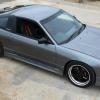Chassis Stiffness Among Models
Announcements
-
Similar Content
-
Latest Posts
-
By SeanR32GtSt · Posted
I know this one’s the BB one. My tuner did make mention about the actuator. I am curious about the VCT as well -
Might also needs a stronger actuator with the right preloading. With older 2019 built bush G3 units, BB upgrade or 21U housing down size makes a pretty decent gain in response as well.
-
By Desean Strickland · Posted
Hey lads so im finally putting together my rb30 forged bottom end and ran into an issue. I measured my main bearing clearance with arp main studs torqued to 60 ft-lbs using ACL H series STD size bearings and standard, un-ground crank shaft journals and got an oil clearance reading of about 1.3 thou measuring straight up and down and about 2.8 thou measuring at a 45 degree angle (just above and below the parting line). My machine shop said they measured the main tunnel and it was all within spec (they didnt say the actual measurement) and to go with a standard size bearing, which i have done and the clearance is too tight, I'm guessing because of the extra clamping force from the arp studs distorting the main tunnel. I was wanting to run about 2.5 thou main bearing clearance. My questions are: 1. could i just use the HX extra 1 thou clearance ACL bearings? that would fix my straight up and down clearance making it about 2.3 thou, but then would the side to side clearance be too big at around 3.8 thou? 2. what actually is the recommended main bearing clearance for measuring near the parting line / side to side. i know its supposed to be bigger as the bearing has some eccentricity built into it but how much more clearance should there be compared to the straight up and down measurement? at the moment there is about 1.5thou difference, is that acceptable or should it be less? 3. If i took the engine block + girdle back to the machine shop and got them to line bore the main tunnel (like i told them to do the first time, but they said it didnt need it) what bearing size would i buy? the STD size bearing shells already slide in fairly easily with no real resistance, some even falling out if i tip the girdle up-side-down. If im taking material out of the main tunnel would i need a bearing with extra material on the back side to make up for it? this is probably confusing af to read so if something doesn't make sense let me know and ill try explaining in a different way. My machine shop doesn't come back from christmas break until mid January, hence why i'm asking these questions here. TIA for any help or info -
I bought the model back in Japan in Feb. I realised I could never build it, looked around for people who could build it, turns out there's some very skilled people out there that will make copies of 1:1 cars or near enough. I'm not really a photo guy... but people were dragging me in a group chat for the choice of bumper as someone else saw the car before it was finished as they are also a customer of that shop. I took the photo in the above post because I was pretty confident that the lip would work wonders for it. Here's some more in-progress and almost-done pics. It gives a good enough idea as to what the rear looks like! I have also booked in a track day at the end of January. Lets all hope that is nothing but pure fun and games. If it's not pure fun and games, well, I've already got half an engine spare in the cupboard
-
By soviet_merlin · Posted
Well, do ya, punk? Seriously though, let's fu<king go! The colour and kit looks amazing on the car. Do you have any shots from the rear? I don't quite follow how the model came around. You bought the white kit and he modified it to match your car? Looks nuts either way!
-







Recommended Posts
Create an account or sign in to comment
You need to be a member in order to leave a comment
Create an account
Sign up for a new account in our community. It's easy!
Register a new accountSign in
Already have an account? Sign in here.
Sign In Now